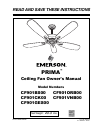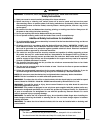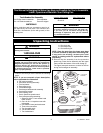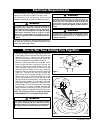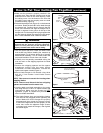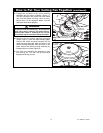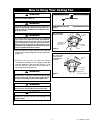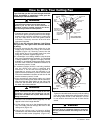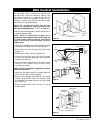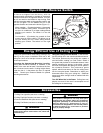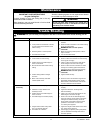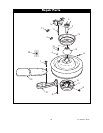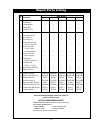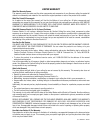
11
Trouble Shooting
WARNING: For your own safety, turn off power at fuse box or circuit breaker before trouble shooting your fan.
TROUBLE PROBABLE CAUSE SUGGESTED REMEDY
1. Fan will not start. 1. Fuse or circuit breaker blown. 1. Check main and branch circuit fuses or circuit
breakers.
2. Loose power line connections to the fan, 2. Check line wire connections in the switch housing
or loose switch wire connections in the to fan and speed switch.
switch housing.
WARNING: Make sure main power is
turned OFF.
3. Reversing switch in neutral position. 3. Make sure reversing switch position is all the
way to one side.
4. Fan Wall Control is OFF. 4. Turn ON Fan Wall Control.
2. Fan sounds noisy. 1. Blades not attached to fan. 1. Attach blades to fan before operating.
2. Loose screws in motor housing. 2. Check to make sure all screws in motor housing
are snug (not over-tight).
3. Screws securing fan blade flanges to 3. Check to make sure the screws which attach
motor hub are loose. the fan flanges to the motor hub are tight.
4. Wire connectors inside switch housing 4. Check to make sure wire connectors in switch
rattling. housing are not rattling against each other or
against the interior wall of the switch housing.
WARNING: Make sure main power is
turned OFF.
5. Screws holding blades to flanges 5. Tighten screws securely.
are loose.
6. Motor noise caused by solid-state 6. Some fan motors are sensitive to signals from
variable speed control. Solid-State variable speed controls. If Solid-
State Control is used and motor noise results
choose an alternative control method.
3. Fan wobbles 1. Setscrew in motor coupling is loose. 1. Tighten both setscrews securely in the motor
excessively. coupling.
2. Setscrew in hanger ball/downrod 2. Tighten the setscrew in the hanger ball/
assembly is loose. downrod assembly.
3. Screws securing fan blade flanges to 3. Check to be sure screws which attach the fan
motor are loose. blade flanges to the motor are tight.
4. Fan blade flanges not seated properly. 4. Check to be sure the fan blade flanges seat
firmly and uniformly to the surface of the motor.
If flanges are seated incorrectly, loosen the
flange screws and retighten according to the
procedure in the section on "How to Put
Your Ceiling Fan Together".
5. Hanger bracket and/or ceiling outlet 5. Tighten the hanger bracket screws to the outlet
box is not securely fastened. box, and/or secure outlet box.
6. Fan blades out of balance. 6. Interchanging an adjacent (side-by-side) blade
pair can redistribute the weight and result in
smoother operation.
!
!
!
U.L. Model No.: CF901
Maintenance
IMPORTANT CARE INSTRUCTIONS
for your Ceiling Fan
Periodic cleaning of your new ceiling fan is the only
maintenance that is needed.
When cleaning, use only a soft brush or lint free cloth
to avoid scratching the finish.
Abrasive cleaning agents are not required and should
be avoided to prevent damage to finish.
Do not use water when cleaning your ceiling fan. It
could damage the motor or the blades and create the
possibility of an electrical shock.
WARNING
!



